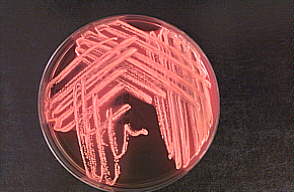|
Bacteria are the oldest
known organisms on Earth. Fossils indicate that bacteria have
inhabited the planet for nearly 3.5 billion years. Over this
time bacteria have evolved into unicellular organisms capable of
existing in the most extreme and diverse conditions. Bacteria
are found on the tops of mountains and in the bottom of oceans,
however, they are most commonly found in our natural environment.
Bacteria
are described as unicellular prokaryote organisms because they do
not possess membrane bound organelles. Instead of having
a membrane bound nucleus bacteria have a nucleoid, a region where
bacterial DNA is localized. Bacteria have many different morphologies.
Cocci are spherical bacteria that can exist singly, in pairs (diphlococci),
in chains (streptococci), or in clusters (staphylococci).
Bacteria also exist as rod shaped structures known as bacillus or
helical structures known as spirilla. Bacteria
are commonly classified on the basis of their cell wall structure
using a technique called the gram stain. The gram stain uses
a violet and iodine dye to stain bacteria. Bacteria with a plasma
membrane and cell wall appear purple, whereas bacteria with an outermembrane,
cell wall, and plasma membrane appear red.
|

|
